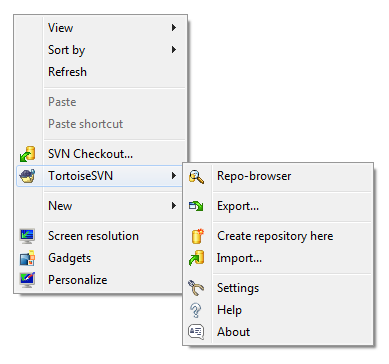About TortoiseSVN

We will use a windows client called TortiseSVN to make it easier to interact with the repository. TortoiseSVN is a really easy to use SCC client for Windows. It is based on Apache™ Subversion (SVN)® and it provides a nice and easy user interface for Subversion. Since it’s not an integration for a specific development environment like Visual Studio, Python, or LabVIEW, you can use it with whatever development tools you like, and with any type of file. As a result, you will use it not only for your Python source files but also for project documentation files in formats such as *.pdf, *.xlsx, and *.docx.
You will use SCC for all of the assignments that you create in this course. A copy of your work will be maintained on a central server and you can check out and work on your code from any computer that has both LabVIEW and TortoiseSVN installed. You will check your code back into the server where it can be accessed by the instructor for grading.
Download and Install TortoiseSVN
For the Fall 2017 semester we are using TortoiseSVN 1.9.6. Download the latest version of TortoiseSVN from https://tortoisesvn.net/downloads.html. Click on the button for your operating system (probably 64 bit) and save the file in you downloads area. Installation is straightforward. Simply run the installer and accept the default settings.
Using TortoiseSVN
TortiseSVN does not show up as a program in your Windows Start Menu. Instead, it is a Windows shell extension which means that it adds functionality to your Windows operating system. You can check to see if it installed properly by right-clicking somewhere on your desktop to get a windows context menu. You should see a couple of entries in this menu for TotrtiseSVN that will resemble the following:

Later, when you begin working with the source-code control system, you will have a local working copy of your files that are associated with the code repository. When you view these files in the windows explorer they will have a set of icon overlays showing their status as in the image below where all of the files are up to date with the repository (indicated by the green check marks). When you modify a file in your working copy this icon overlay will change to a red X indicating that this file needs to be committed back to the code repository. There are additional icons that indicate different file status cases.
![]()
Icon Overlays Missing From Windows Explorer
In some cases you may find that the TortiseSVN icon overlays that identify the status of files within the source code control system do not show up in Windows Explorer. This is usually due to the fact that Windows only has a limited number of slots available for icon overlays, and other software such as DropBox, OneDrive, or Windows itself, may be pushing TortiseSVN icons out of the way. In order to remedy this problem, right click on your desktop and select TortiseSVN>Settings, then select the Icon Overlays>Overlay Handlers page.
![]()
There is a button on this page that will start the Windows Registry Editor and take you directly to the registry key
HKEY_LOCAL_MACHINE\SOFTWARE\Microsoft\Windows\CurrentVersion\explorer\ShellIconOverlayIdentifiers
You can delete entries for any items that you know you do not need, or rename the entries to make sure that the TortiseSVN icons are at the top of the list. One trick is to put spaces in front of the TortiseSVN entries so that they will move up alphabetically. Always use extreme caution when working with the Registry Editor. Use the Registry Editor at your own risk !! You will have to restart your system in order for the changes that you make to take effect.
![]()
Icon Overlays Missing From File Dialogs
On 64-bit versions of Windows, the TortoiseSVN context menu and icon overlays won’t show for 32-bit applications (such as LabVIEW) in their file-open/save dialogs until you install the 2015 C-runtime for x86. This only applies to 32-bit applications on x64 OS. The Windows explorer is not affected by this.


